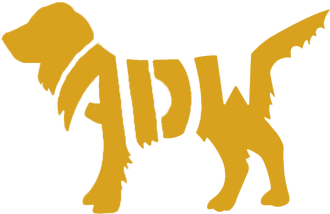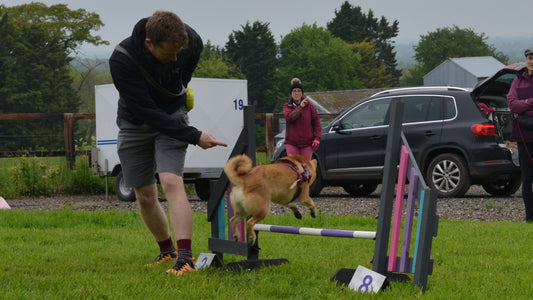Dog Agility Weaves: A 1-Month Training Guide for You and Your Dog
This guide will take you through channel weaves, the 2×2 method, V weaves, and progression options for you to practice at home, or in class, so you and your dog can learn to weave confidently in just one month.
What Are Weave Poles?
Weave poles are a standard agility obstacle, consisting of 6 or 12 poles set in a straight line. The goal is for your dog to learn the correct pattern, entering with their left shoulder, passing the first pole, and slalom through each pole without skipping any.
Building Independence from the Handler
A key goal of agility is teaching your dog to work independently. Because they're much quicker than us we don't want reliance on us pulling them out of the channel before they've done all 12. By rewarding at the end of the weaves with a predictable target, your dog learns to focus on completing the obstacle rather than checking where you are.
TP: The target can be a toy, bowl, or hoop to toss rewards into but in my experience, a training mat like a Place Board works better as the alternatives can be too exciting, causing your dog to rush or skip poles.
A target teaches your dog that the reward location is always the same. By only rewarding at the end, you help your dog focus on completing all poles correctly rather than preempting the next obstacle.
You can find our place boards here: Shop Place Boards.
A prerequisite to starting this weave programme is that your dog is T.A.R.G.E.T. trained to use a platform such as a Place Board.
Start Training
Q: Does your dog go onto a Place Board and into a sit from 5 paces away when cued like the short clip below?

Image 1: A Young gundog being sent to a Place Board independently from 5 paces away.
If yes, go to the next step. If not, check out our eBook for guidance
Start with Channel Weaves
Channel weaves are an introductory method where poles are set with a gap between them, forming a “channel” for your dog to go down.
Instead of weaving in and out of individual poles immediately, your dog learns to run down the line of the poles, without skipping any.
This can also encourage drive and help your dog develop a rhythm.
Common Dog Gaits in Weaving
When dogs are learning, they often experiment with two gaits:
-
Bounce: The dog bounces on its front two legs.
-
Swim/Paddle: The dog uses one leg to push off
TIP: video your training to see which your dog is doing. The goal is to practice until you see a consistent gait that suits your dog’s size and style.
The 2×2 Method
Instead of starting with all 12 poles, you begin with two poles and gradually increase the number with each success.
Step 1 – Start with Two Poles
Setup:
Set one pole on the left, 60 cm ahead (roughly two foot lengths), put one on the right, making a 40cm wide channel.
Place a place board at the exit (beyond the right pole).
How:
Handle using the arm and leg closest to your dog, with a “bowling action.”
Example: Dog on left → step forward with your left arm and left leg → say place.
When your dog hits the board, go to their position and reward them. The dog learns that the reward always happens at the end.
Step 2 – Gradually Add Poles
Once your dog comfortably navigates two poles, add two more poles, one left, one right, 60cm apart, to create another set framing the 40cm wide channel.
Goal to achieve: continue this process until your dog is running through a full line of 12 poles to the Place Board at the end.

Image 2: Betsy learning to weave for the first time using a channel of V weaves
Note, the handler is using a different handling method (luring) not a target like we will be here.
Step 3 – Close the Gap Between Sets
As your dog becomes more confident, gradually close the gap until the weave line is continuous.
Initially, use V-weaves. The V's angle helps your dog maintain the correct weaving pattern. Dogs move in a zigzag pattern, following the V’s angle.
The V can be widened to support your dog or made narrower to progress.
This method bridges the gap between beginner channel weaves and competition poles.

Image 3: Reggie doing a straight set of V weaves in his second weave session
Note, the handler is using a different handling method (luring) not a target like we will be here.
Goal to achieve: your dog can run 12 poles in a V shape without skipping any to a Place Board at the end.
Traditional weave poles

Image 3: Harper, an experienced dog, doing upright weaves
Goal to achieve: your dog can run 12 upright poles with no target at the end
1-Month Weave Training Progression – Tick List
Work through each step at your own pace. Tick off the skills once you and your dog can confidently and consistently achieve them.
Week 1
☐ I can send my dog to a place board from 5 paces away without moving.
☐ My dog can run through 2 poles to a place board.
☐ My dog can run through 4 poles in a channel.
☐ My dog can run through 6 poles in a channel.
☐ My dog can run through 12 poles in a channel, set to the width of my dog’s shoulders.
☐ I have practised handling my dog on my left side.
☐ I have practised handling my dog on my right side.
Week 2
☐ I can run my dog through 6 poles in a narrowed channel.
☐ I can run my dog through 12 poles in a narrowed channel.
☐ My dog has tried V weaves.
☐ I can complete a front cross before the weave entry.
☐ I can complete a rear cross, crossing behind my dog while they are in the weave channel.
TIP: If you're practising at home and don't have a jump, you can still send your dog around a cone placed 5 paces from the weave entry and practice your crosses that way.
Week 3
☐ My dog can run through 12 poles set as V weaves in a straight line.
Angled exits:
Start teaching your dog to weave without you running alongside the whole way.
☐ Try decelerating just before the exit.
☐ Instead of staying parallel, begin close then angle out toward the next obstacle. This teaches your dog to drive independently.
Handler tip: keep your chest angled slightly toward the weave channel so the dog is not pulled off course. Don’t go quiet — dogs may turn to look for you.
Week 4
Angled entries: The 'go round' on the pink jump in the course map below can be substituted for a wing wrap (left & right) or omitted, to create more challenging entry angles.
If you're practising at home and don't have jumps, you can still start at the same angle and send without them crossing an obstacle.
☐ My dog can complete a weave entry from a go-round.
☐ My dog can complete a weave entry from a wing wrap on the pink jump (left “wrap” & right “check”).
☐ My dog can enter the weaves from jump #1 (omitting #2).
☐ My dog can enter the weaves from jump #4 (omitting #5).
Example course

Future challenges:
Using this same course, you could practice even more challenging themes. For example, a harder angle would be to send your dog over #4 in the opposite direction (down on this map, not up) into the weaves from the far end.
You could add a jump on the left-hand side parallel to the weave line to practice layering.
A tunnel could be added at the end for obstacle discrimination.
Like the content we put out and want to stay updated and in the know?

Join our subscribers to gain short weekly emails (under 1-minute reads) plus the opportunity to reach out & get professional advice on your own training challenges. Read answers to members' FAQs, receive training & equipment news offers and tips directly to your inbox.
Click here to join our subscribers
About the author: Hi 👋 I’m Emma, accredited as a professional dog trainer by the Institute of Modern Dog Trainers (IMDT). I help owners of energetic dogs achieve the dog-owning life they envisioned by providing robust obedience & agility training for dogs across my two venues in Balsham and Barton, near Cambridge.
Disclaimer: The content of this article does not include personalised advice and is for information purposes only. If you need individual advice or other enquiries please click here to get in contact or if you're not local to Anglian Dog Works, you can find a trainer in your area by going to the IMDT website: https://www.imdt.uk.com/find-a-qualified-imdt-trainer


